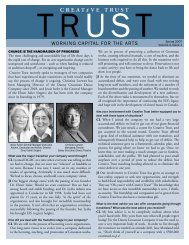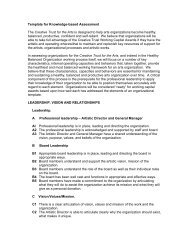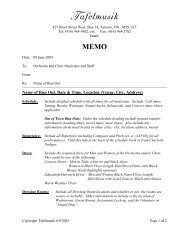20 Questions - Canadian Institute of Chartered Accountants
20 Questions - Canadian Institute of Chartered Accountants
20 Questions - Canadian Institute of Chartered Accountants
You also want an ePaper? Increase the reach of your titles
YUMPU automatically turns print PDFs into web optimized ePapers that Google loves.
Appendix 3<br />
The Board’s Role in the Planning Process<br />
An effective planning process typically has several phases:<br />
• Preparation<br />
• Discussion<br />
• Approval<br />
• Communication<br />
Preparation<br />
The planning process begins with staff preparing for the board session by assembling<br />
background information and recommendations. The agenda package for the<br />
planning session might include:<br />
• Previous year’s plans, budgets, financial and statistical information<br />
• A summary <strong>of</strong> the current year’s activities and progress, etc.<br />
• Information from conferences <strong>of</strong> organizations in similar fields<br />
• Directions from any national or international body<br />
• Information on government policy and legislation that could affect the<br />
organization<br />
• The key issues identified by SWOT analysis and risk management procedures<br />
• Management’s strategic recommendations<br />
This material forms part <strong>of</strong> the planning records and should be retained for use in<br />
the plan and for future reference.<br />
Discussion<br />
The board meets with key staff and volunteers (where appropriate) to discuss and<br />
approve staff recommendations. This is frequently held at a facility that is away<br />
from distractions and equipped to facilitate discussion. The minutes and notes<br />
from the planning session also become part <strong>of</strong> the planning records. They provide<br />
guidance for staff in developing plans and a record for the board <strong>of</strong> discussions<br />
and decisions. They may include:<br />
• Decisions to retain or amend the Vision, Mission and Values<br />
• Decisions to continue or change the organization’s strategy<br />
• New projects and programs including timing and the names <strong>of</strong> the individuals<br />
or committees responsible for them<br />
• The key measurements that will be used to monitor performance and progress<br />
Approval<br />
Using the guidance and approvals from the board strategy session, staff prepare<br />
the formal strategic plan and present it to the board for approval at a board<br />
meeting.<br />
Communication<br />
Once the board has approved the strategy and plan they can be communicated to<br />
staff and volunteers for use in developing the operational and capital plans and<br />
budgets.<br />
The board should make sure that the strategy is communicated (usually in abbreviated<br />
form) to key stakeholders. This can contribute to building community<br />
interest, support and funding for the organization’s programs and activities.<br />
27












